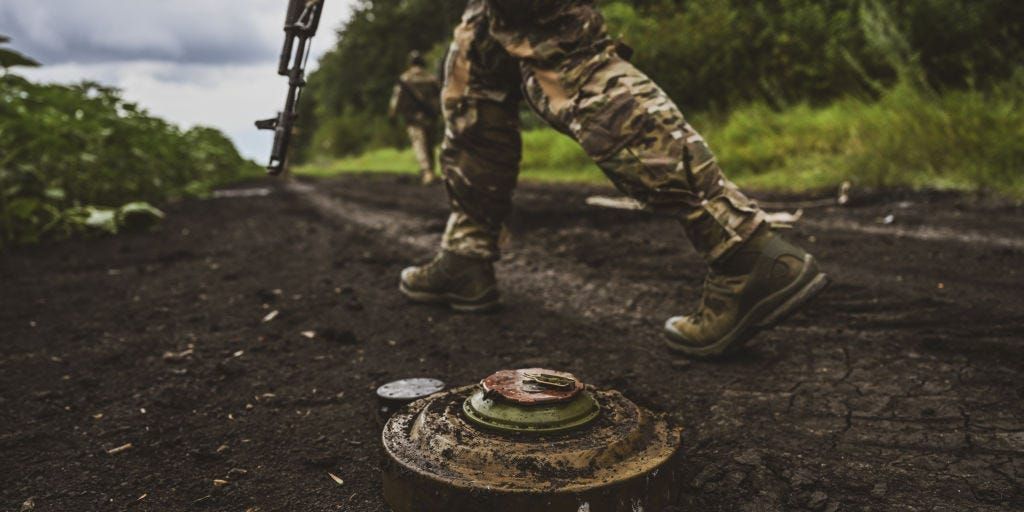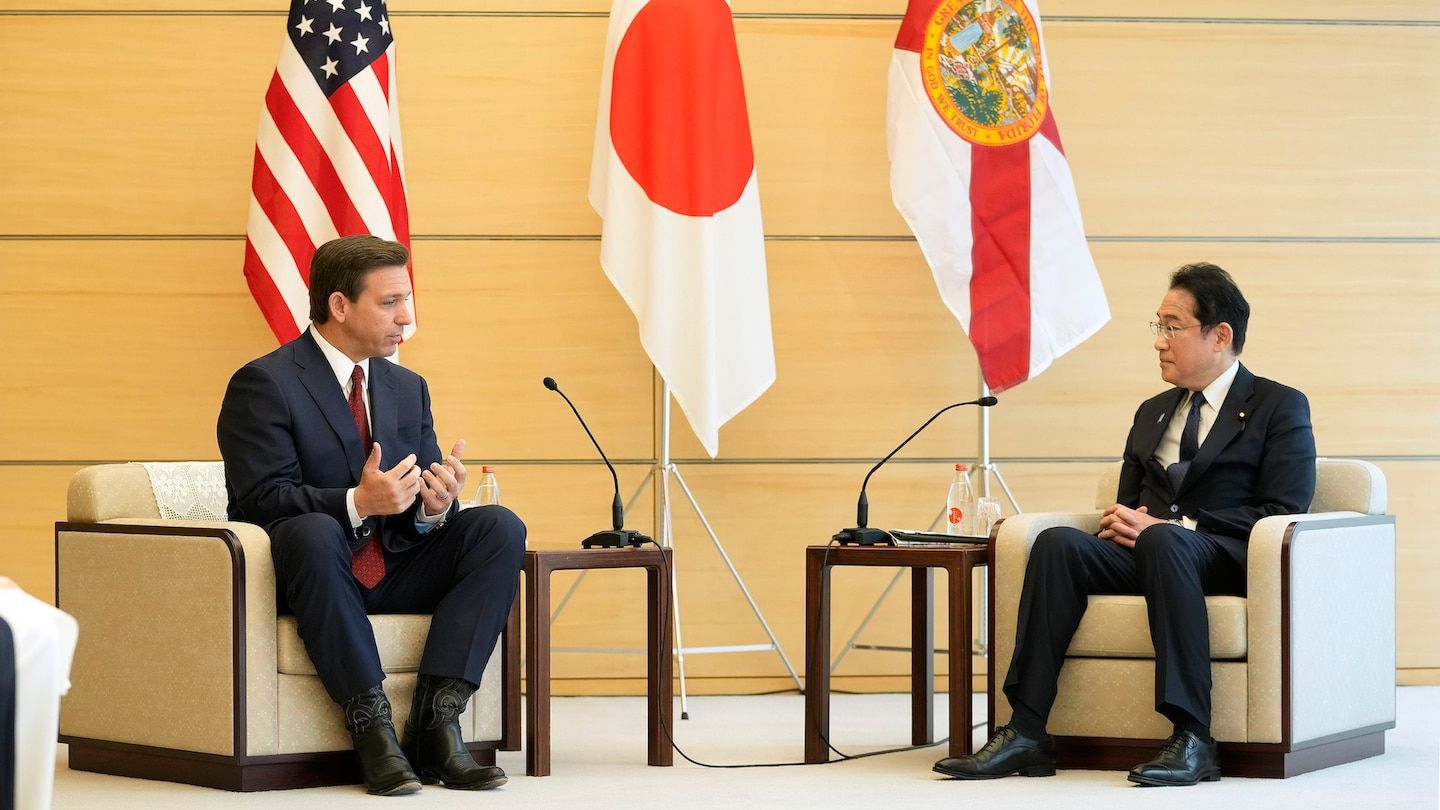Ex-Special Forces Engineer Says Russian Land Mines Are 'Exhausting'
Ryan Hendrickson has been working to clear heavily mined areas in Ukraine.
The former US Special Forces engineer says the overwhelming numbers of land mines is wildly different from anything he saw in Afghanistan.
"How do you clear all of this out?" Hendrickson asked in an online interview with a Ukrainian YouTube channel.
Get the inside scoop on today’s biggest stories in business, from Wall Street to Silicon Valley — delivered daily. Loading Something is loading. Thanks for signing up! Access your favorite topics in a personalized feed while you're on the go. download the app Email address By clicking ‘Sign up’, you agree to receive marketing emails from Insider as well as other partner offers and accept our Terms of Service and Privacy Policy
A decorated former US Army Special Forces engineer who cleared out improvised explosives in Afghanistan and has since been tackling threats in Ukraine says the monstrous minefields Russia is laying down are unlike anything he has ever seen.
"The biggest difference is the sheer number of mines," Ryan Hendrickson, who previously served in Afghanistan with the Green Berets and is now removing deadly mines as a volunteer in Ukraine, told Ukrainian Toronto Television. "There are millions and millions of mines in Ukraine," many put down by the Ukrainians, but significantly more by the Russians.
In one field, for instance, Hendrickson and his team found over 700 anti-tank mines, though they estimated there may have been thousands in total. That was just one field.
The Russians have "the capability to lay millions and millions of land mines, and they do," he said, stressing that "the biggest shaping factor of this war is land mines."
"Everything is landmined," he said in the interview, explaining that in Ukraine right now "all the farm fields are landmined, all the routes are landmined," and, in sectors along the front, "if the routes aren't landmined, then artillery has target reference points along the routes."
Hendrickson is involved with the Tip of the Spear initiative, his crowdfunded organization focused on removing land mines and booby traps in areas in the rear, areas where civilians are most at risk of being hurt or killed. In the field, he said, he and his team have encountered complex schemes where the minelayers intended to trap and maim or kill the de-mining crews, which are out in it working primarily on foot using man-portable mine-clearing tools.
Ukrainian army's 35th Marine Brigade members conduct mine clearance work at a field in Donetsk, Ukraine on July 11, 2023. Ercin Erturk/Anadolu Agency via Getty Images
Hendrickson indicated he is overwhelmed by the number of mines in Ukraine and the daunting task that lies ahead.
He said that based on what he has seen, it is plausible that Ukraine will not ever be completely de-mined. "There's too many land mines," he told the Ukrainian YouTube channel. And there's likely to be many more before all is said and done. As they are effective death traps that are dangerous and "exhausting" to deal with, mines are just not going away.
'Hidden threats'
Land mines come in different shapes and sizes. There are anti-personnel mines and anti-tank mines, among other types, and these have been used extensively, often to potent yet tragic effect, in a number of modern conflicts. Explosive remnants of those wars can still be seen in places like Laos and Cambodia, for example.
"Land mines are extremely effective," Hendrickson said, pointing out that thousands of lethal mines can be put down in a matter of hours, creating severe problems for any advancing forces.
"You have to deal with the hidden threats, the threats you can't see that are underneath the ground," he said of the difficulties presented by mines. "Mentally, it's exhausting."
The retired soldier said that he and his team have encountered extremely complex minefields in Ukraine in which anti-tank mines are protected by anti-personnel mines and other explosives surrounded by booby traps. "How do you clear all of this out? It's just slow," he explained.
Human Rights Watch, wrote in a recent report on the use of land mines in Ukraine that "the use of antipersonnel and anti-vehicle mines in the armed conflict is resulting in a large, dispersed, and complex level of contamination that will threaten Ukrainian civilians and hinder recovery efforts for years to come."
'Mentally tasking'
Hendrickson described the mine-clearing process as "methodical" in his interview with Ukrainian Toronto Television.
The problem with that is while de-mining work in areas outside of combat is able to happen at its own pace, front-line combat is substantially less permissive, forcing crews to work only when they have sufficient protection or when they are less visible, such as at night.
Ukrainian army's 35th Marine Brigade members conduct mine clearance work at a field in Donetsk, Ukraine on July 11, 2023. The Engineer Group of the same brigade supported the operation. Ercin Erturk/Anadolu Agency via Getty Images
Hendrickson recalled clearing operations in Afghanistan. "We were up in the front with our detectors clearing the path for the assaulters," he said. "It's extremely mentally tasking because not only are you worried about what you can't see underneath the ground, but you're right up in the front. Who's going to get shot first? Who's going to walk into that ambush first?"
Ukrainian forces are executing a counteroffensive push that's being hindered by mines, among other challenges, and there's growing evidence that these minefields should have been considered a more difficult threat to offensive operations.
"Any movement, offense, or counteroffense, assaults, or anything like that, the commander has to take into account land mines," Hendrickson said.
If the land mine problem wasn't carefully considered before, that certainly is not the case now.
Gen. Valery Zaluzhny, commander-in-chief of Ukraine's armed forces, recently told The Washington Post that "you can no longer do anything with just a tank, with some armor, because the minefield is too deep, and sooner or later, it will stop and then it will be destroyed by concentrated fire."
And Zaluzhny isn't the only top general that has figured out that mines are a huge problem for the ongoing counteroffensive.
"The casualties that the Ukrainians are suffering on this offensive," Chairman of the Joint Chiefs of Staff US Army Gen. Mark Milley said this week, "they're from minefields — minefields that are covered with direct fire from anti-tank hunter-killer teams, that sort of thing."
"The real problem is the minefields," he said, and if there's no change, Ukraine could find itself stuck in a war of attrition in which terrible infantry battles and artillery duels grind away at both armies.
It's the kind of warfighting Ukraine simply can't afford to engage in if wants to drive the Russians out and ultimately take back all of its lost territory, another daunting task.
Source: Business Insider


